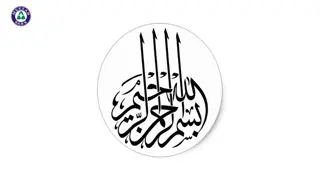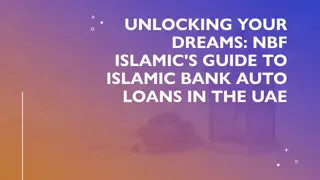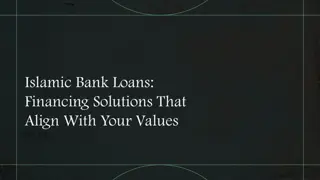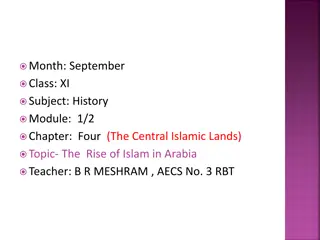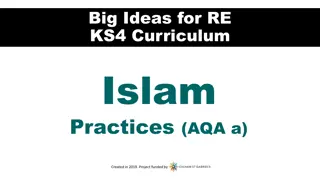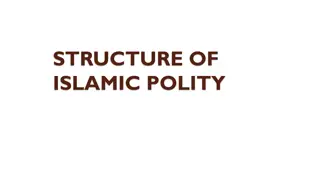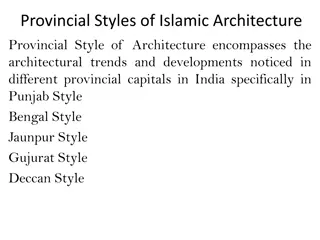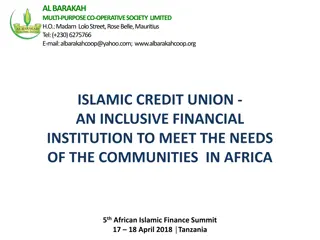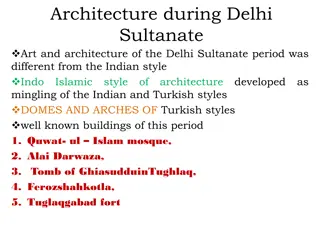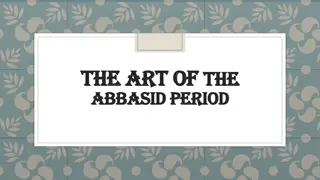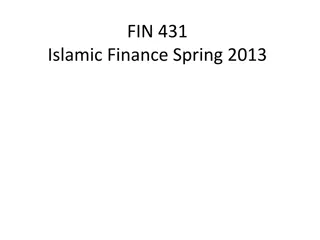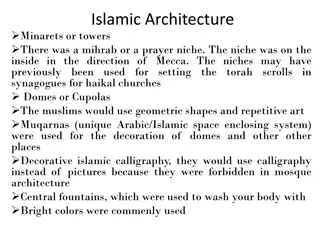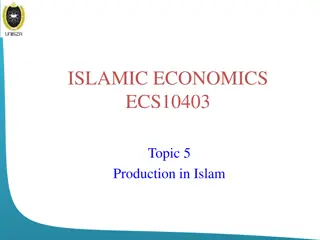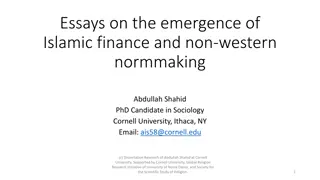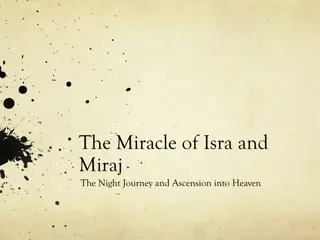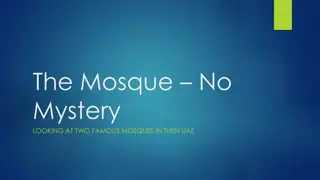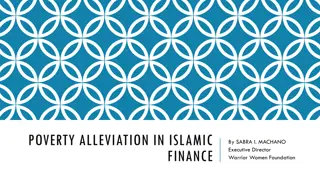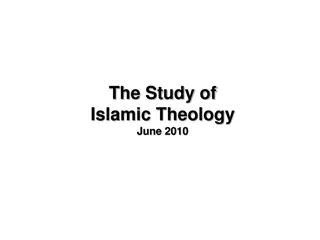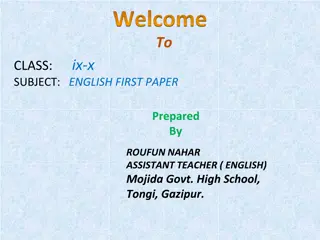Exploring Islamic Art and Architecture at Al-Fateh Mosque
Discover the intricate beauty of Islamic art and architecture at Al-Fateh Mosque through the incorporation of geometric shapes, Arabic calligraphy, and traditional motifs. Learn about the significance of elements such as the Mihrab and Kufic script in expressing cultural and religious identity within Islamic artistic practices.
Download Presentation

Please find below an Image/Link to download the presentation.
The content on the website is provided AS IS for your information and personal use only. It may not be sold, licensed, or shared on other websites without obtaining consent from the author. Download presentation by click this link. If you encounter any issues during the download, it is possible that the publisher has removed the file from their server.
E N D
Presentation Transcript
Secondary Education Grade 11 Second semester Eng. 202: New Language Leader Unit 7: Design ( Lesson 7.1 ) Design is everywhere
At the end of this lesson, you will be able to: - locate information from a text. - write a short descriptive paragraph.
Read this text and then fill the blanks( 1-6 ) with suitable sentences (a-f ) from the box. Islamic Art in Al-Fateh Mosque Typically Islamic art has focused on the depiction of patterns and Arabic calligraphy, rather than on figures. Geometric Shapes and Repetitive Art (arabesque) The eye cannot miss the geometric shapes and patterns at Al-Fateh Mosque. ( 1 )---------------------------------------------------------------------------- -------------------. Though this kind of art is not part of the Islamic faith, yet the fact that art is a form of expression cannot be ignored. Common interpretations of this art include the following: The concept of God's infinite power is expressed through geometry and designs with repeating themes which suggest infinity. Kufic is the oldest calligraphic form of the various Arabic scripts and can be found adorning the walls of Al-Fateh Mosque. Its name is derived from the city of Kufa in Iraq although this script was known in Mesopotamia at least 100 years before the foundation of Kufa. ( 2 ) -- ---------------------------------------------------------------------------. It was in this script that the first copies of the Qur'an were written. It is still employed in Islamic countries though it has undergone a number of alterations over the years and also displays regional differences. a) It consists of straight lines and angles, often with elongated verticals and horizontals. shaped to bounce the sound back and magnify it at the same time. It is both a landmark and place from which the call to prayer is broadcast they have a function and position more similar to that of a lectern: emphasizing contact with the audience. Distinguishing motifs of Islamic architecture have always been ordered repetition and rhythmic, metric patterns. These appear everywhere: on the marble floor, on the carpets, on the walls, on the doors and on the windows. b) c) d) e) f) Eng. 202 Unit 7 / Lesson 1 Design is everywhere Ministry of Education Second Semester 2020 / 2021
Islamic Architecture in Al-Fateh Mosque The word mosque is the translation of the Arabic word masjid which is any clean place where one can perform prostration (sujood) to God. A building where people can prostrate together with others is therefore called a masjid. ( 3 ) ------------------------------------------------------------------------------------- --. In this respect, fractal geometry has been a key utility, especially for mosques. Other significant features employed as motifs include columns, piers and arches. Arabic Calligraphy is used to enhance the interior of a building by providing quotations from the Qur'an. You can see the following traditional elements at Al-Fateh Mosque. Mihrab A mihrab is a niche in the wall of a mosque where the Imam (the prayer leader) stations himself to lead the congregation in prayers. The Mihrab is an acoustic device, a resonator for the voice, ( 4 ) ------ ----------------------------------------------. Since this is where the Imam prays, the Mihrab therefore indicates the qibla, that is, the direction of the Kaaba (a prayer house built by Prophet Abraham and his son Ishmael in Mecca) and hence the direction that Muslims should face when praying. a) It consists of straight lines and angles, often with elongated verticals and horizontals. shaped to bounce the sound back and magnify it at the same time. It is both a landmark and place from which the call to prayer is broadcast they have a function and position more similar to that of a lectern: emphasizing contact with the audience. Distinguishing motifs of Islamic architecture have always been ordered repetition and rhythmic, metric patterns. These appear everywhere: on the marble floor, on the carpets, on the walls, on the doors and on the windows. b) c) d) e) f) Eng. 202 Unit 7 / Lesson 1 Design is everywhere Ministry of Education Second Semester 2020 / 2021
Minbar (also pronounced mimbar) Prophet Muhammad (peace and blessings of God be upon him) stood on a platform with three steps in order to preach. This platform developed into a minbar which is a pulpit in the mosque where a khatib (person who gives a speech) stands to deliver sermons (khutbah). Being raised above the ground allows the person to see all the worshippers in case of a large crowd. While minbars are usually more akin to pulpits in elevation and structures, ( 5 ) ---------- ------------------------------------------------------------------------------. Minaret The minaret serves a dual function. ( 6 ) -------------------------------- ------------------------------------------------------. At the time of Prophet Muhammad the one who gave the call to prayer used to give the call from the roof of a building. It was not until the 14th century that the minaret became a universal feature of mosques. The minaret is a tall, slender tower attached to a mosque. Each minaret has a balcony that the muathin uses to give his call. The height of the minaret, over a neighborhood has helped the sound to be transmitted. In most modern mosques, as in Al-Fateh Mosque, the athan (call to prayer) is no longer given in the minaret, but in the prayer hall via a microphone. A single minaret is the norm, but some mosques do have more than one minaret. Al-Fateh Mosque has two minarets, each rising to 70 meters (230 feet) above the ground level. a) It consists of straight lines and angles, often with elongated verticals and horizontals. shaped to bounce the sound back and magnify it at the same time. It is both a landmark and place from which the call to prayer is broadcast they have a function and position more similar to that of a lectern: emphasizing contact with the audience. Distinguishing motifs of Islamic architecture have always been ordered repetition and rhythmic, metric patterns. These appear everywhere: on the marble floor, on the carpets, on the walls, on the doors and on the windows. b) c) d) e) f) Eng. 202 Unit 7 / Lesson 1 Design is everywhere Ministry of Education Second Semester 2020 / 2021
Model Answers Islamic Art in Al-Fateh Mosque Typically Islamic art has focused on the depiction of patterns and Arabic calligraphy, rather than on figures. Geometric Shapes and Repetitive Art (arabesque) The eye cannot miss the geometric shapes and patterns at Al-Fateh Mosque. ( F ) These appear everywhere: on the marble floor, on the carpets, on the walls, on the doors and on the windows. Though this kind of art is not part of the Islamic faith, yet the fact that art is a form of expression cannot be ignored. Common interpretations of this art include the following: The concept of God's infinite power is expressed through geometry and designs with repeating themes which suggest infinity. Kufic is the oldest calligraphic form of the various Arabic scripts and can be found adorning the walls of Al-Fateh Mosque. Its name is derived from the city of Kufa in Iraq although this script was known in Mesopotamia at least 100 years before the foundation of Kufa. ( A ) It consists of straight lines and angles, often with elongated verticals and horizontals. It was in this script that the first copies of the Qur'an were written. It is still employed in Islamic countries though it has undergone a number of alterations over the years and also displays regional differences. Eng. 202 Unit 7 / Lesson 1 Design is everywhere Ministry of Education Second Semester 2020 / 2021
Islamic Architecture in Al-Fateh Mosque The word mosque is the translation of the Arabic word masjid which is any clean place where one can perform prostration (sujood) to God. A building where people can prostrate together with others is therefore called a masjid. ( E ) Distinguishing motifs of Islamic architecture have always been ordered repetition and rhythmic, metric patterns. In this respect, fractal geometry has been a key utility, especially for mosques. Other significant features employed as motifs include columns, piers and arches. Arabic Calligraphy is used to enhance the interior of a building by providing quotations from the Qur'an. You can see the following traditional elements at Al-Fateh Mosque. Mihrab A mihrab is a niche in the wall of a mosque where the Imam (the prayer leader) stations himself to lead the congregation in prayers. The Mihrab is an acoustic device, a resonator for the voice, ( B ) shaped to bounce the sound back and magnify it at the same time. Since this is where the Imam prays, the Mihrab therefore indicates the qibla, that is, the direction of the Kaaba (a prayer house built by Prophet Abraham and his son Ishmael in Mecca) and hence the direction that Muslims should face when praying. Eng. 202 Unit 7 / Lesson 1 Design is everywhere Ministry of Education Second Semester 2020 / 2021
Minbar (also pronounced mimbar) Prophet Muhammad (peace and blessings of God be upon him) stood on a platform with three steps in order to preach. This platform developed into a minbar which is a pulpit in the mosque where a khatib (person who gives a speech) stands to deliver sermons (khutbah). Being raised above the ground allows the person to see all the worshippers in case of a large crowd. While minbars are usually more akin to pulpits in elevation and structures, ( D ) they have a function and position more similar to that of a lectern: emphasizing contact with the audience. Minaret The minaret serves a dual function. ( C ) It is both a landmark and place from which the call to prayer is broadcast. At the time of Prophet Muhammad the one who gave the call to prayer used to give the call from the roof of a building. It was not until the 14th century that the minaret became a universal feature of mosques. The minaret is a tall, slender tower attached to a mosque. Each minaret has a balcony that the muathin uses to give his call. The height of the minaret, over a neighborhood has helped the sound to be transmitted. In most modern mosques, as in Al-Fateh Mosque, the athan (call to prayer) is no longer given in the minaret, but in the prayer hall via a microphone. A single minaret is the norm, but some mosques do have more than one minaret. Al-Fateh Mosque has two minarets, each rising to 70 meters (230 feet) above the ground level. Eng. 202 Unit 7 / Lesson 1 Design is everywhere Ministry of Education Second Semester 2020 / 2021
Assessment Reacting to the text Which part of Al-Fateh Mosque is the most interesting for you? Why? Eng. 202 Unit 7 / Lesson 1 Design is everywhere Ministry of Education Second Semester 2020 / 2021
Word Building Task Look at the table below and complete the word families. Noun Noun ( Person ) Verb Adjective ( thing or concept) design architecture construct innovation Eng. 202 Unit 7 / Lesson 1 Design is everywhere Ministry of Education Second Semester 2020 / 2021
Word Building Model Answer Look at the table below and complete the word families. Noun Noun ( Person ) Verb Adjective ( thing or concept) design design designer ---------- --------- architecture architect architectural constructional constructive construct construction constructor Innovate innovation ----------- innovative Eng. 202 Unit 7 / Lesson 1 Design is everywhere Ministry of Education Second Semester 2020 / 2021
Write down as many adjectives as you can to describe designs -------------------------------------------------------------------------------------------------- -------------------------------------------------------------------------------------------------- -------------------------------------------------------------------------------------------------- -------------------------------------------------------------------------------------------------- -------------------------------------------------------------------------------------------------- ------------------------------------------------------------------------------------------------- Eng. 202 Unit 7 / Lesson 1 Design is everywhere Ministry of Education Second Semester 2020 / 2021
Model Answer functional useful efficient stylish trendy modern contemporary vintage traditional classic streamlined classy elegant sophisticated chic good looking artistic creative innovative original decorative intricate simple easy to use durable value for money cost effective sleek conventional geometric angular latest Colored ancient familiar fashioned Eng. 202 Unit 7 / Lesson 1 Design is everywhere Ministry of Education Second Semester 2020 / 2021
Describe an object Name: It is a/an .. It was invented ( produced ) by . in .. Size/ weight: It is (small/tiny/big/light/lightweight/heavy/bulky/compact/pocketable/portable . ) -It weighs just/about . (200g/3.5 kg). -It is about the same size as ../ It is as big as .. -It is (larger, smaller, wider) than .. Color: - It is . - Its (frame/face/cover ) . is (silver/black/white/blue ) -It is available in several colors. -It comes in different colors. / It only comes in (white). Eng. 202 Unit 7 / Lesson 1 Design is everywhere Ministry of Education Second Semester 2020 / 2021
Material: It is made of (fiber/aluminum/plastic/steel/leather/wood/rubber) Shape: It is (curved/ streamlined/circular/angular/ rectangular .) Purpose: -It is versatile. (It can be used for many different purposes) -It is used to (verb) / You can use it to -It is used for (noun) -It is user friendly. -It is very easy to use. -It can be adjusted quickly. -It is very useful and essential especially in/for/ ............. -It aims to .. -It also acts as . -It is ideal for use in/on/ by -It will appeal to . -It is perfect for . -It is aimed at . -It is also suitable for .. Eng. 202 Unit 7 / Lesson 1 Design is everywhere Ministry of Education Second Semester 2020 / 2021
Style: It looks very (modern/stylish/retro/vintage/classic/elegant/ innovative/ artistic/ ) Other features: - It has several special/unique features -It consists of . -It has . -It has a lifetime guarantee. -It is waterproof/ heat resistant/ . -durable/functional -It has got a handle/ a lid/ buttons/ a screen/ batteries/ a motor/ cables/ pipes? Price: -It is as cheap as . -It is cheaper than .. -It costs US$ . -It is affordable/ costly/expensive / a good value for money/ . Eng. 202 Unit 7 / Lesson 1 Design is everywhere Ministry of Education Second Semester 2020 / 2021
Its your turn to describe an object Think about an object which has a special design and write a short descriptive paragraph about it. ----------------------------------------------------- ----------------------------------------------------- ----------------------------------------------------- ----------------------------------------------------- ----------------------------------------------------- ------------------------------------------- In the coming slides are some information that you may need and will guide you. Eng. 202 Unit 7 / Lesson 1 Design is everywhere Ministry of Education Second Semester 2020 / 2021
I use a topic sentence and identify the object. I provide background information about the object. I use enough adjective to make the description of its design clear for the reader and enjoyable. I used the appropriate punctuation marks & the right capitalization. I wrote between 100 - 120 words. I revised my paragraph. ------------------------------------------- ------------------------------------------- ------------------------------------------- ------------------------------------------- ------------------------------------------- ------------------------------------------- ------------------------------------------- ------- Self- Assessment criteria Eng. 202 Unit 7 / Lesson 1 Design is everywhere Ministry of Education Second Semester 2020 / 2021
This is the end of the lesson. THANK YOU FOR YOUR ATTENTION. Eng. 202 Unit 7 / Lesson 1 Design is everywhere Ministry of Education Second Semester 2020 / 2021




